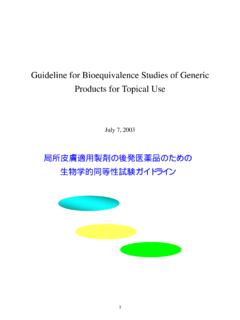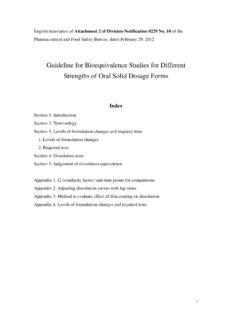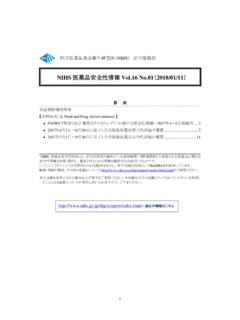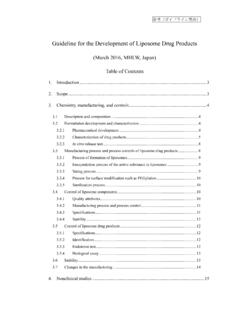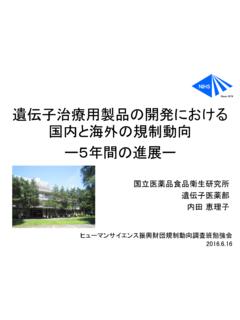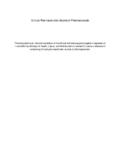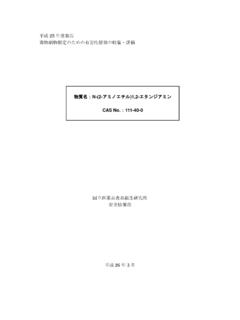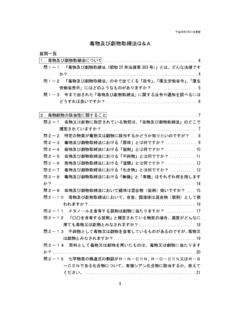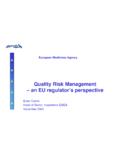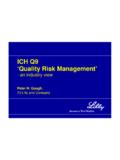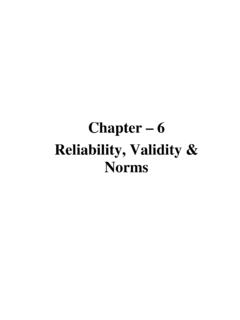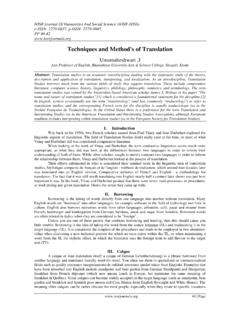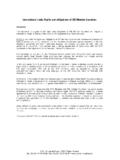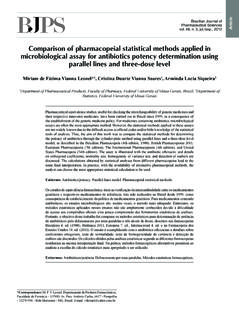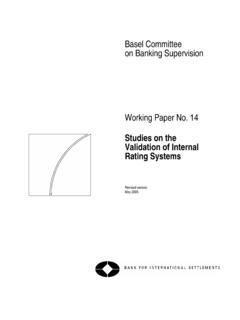Transcription of Guideline for Bioequivalence Studies of Generic …
1 1 English translation of Attachment 1 of Clerical Notification of Pharmaceutical and Food Safety Bureau, dated February 29, 2012 Guideline for Bioequivalence Studies of Generic Products Q & A General Matters Q-1 This Guideline differs from the corresponding WHO Guideline * in terms of the extent of requirements, mainly in the following 3 points. Please explain the reason for the differences. (1) A difference in the lot size of test products. (2) The WHO Guideline requires a minimum of 12 subjects, but this Guideline accepts Studies with 12 subjects or less. (3) If the dissolution profile exhibits similarity or equivalence**, some products may be assessed as biologically equivalent even if the confidence intervals are wider than the acceptable range of Bioequivalence .
2 * Multisource ( Generic ) pharmaceutical products: guidelines on registration requirements to establish interchangeability (WHO Technical Report Series, No. 937, Annex 7, 2006). ** In the Guideline , similarity of the dissolution profile is applied to immediate-release products and enteric-coated products. Equivalence in the dissolution profile is applied to extended-release products. Refer to Q35 in Q&A on the Guideline for Bioequivalence Studies for Different Strengths of Oral Solid Dosage Forms and the Guideline for Bioequivalence Studies for Formulation Changes of Oral Solid Dosage Forms for further information on equivalence and similarity of dissolution profiles.
3 (A) With regard to (1), the WHO Guideline specifies that test products should ideally be taken from industrial scale batches, and when this is not feasible, from batches not smaller than 10% of the expected full production batches, or 100,000 units (hereafter referred to as tablets), whichever is higher. However, in Japan, full production of Generic products is often approximately 100,000 tablets. If the lot scale is 1/10 or larger of the full production lot, and the same manufacturing method as the full production lots is used, drug product characteristics of the test products are considered to be equivalent to those of the full production lots.
4 This can be confirmed in dissolution tests. Therefore, a lot size of the test product is stipulated as at least 1/10 of the full production size, and it does not necessarily require more than 100,000 tablets. With regard to (2), it is possible to demonstrate Bioequivalence in a study with 12 subjects or less, when intra-subject variability is small. This Guideline does not specify the number of subjects to avoid an unnecessary increase in the sample size. With regard to (3), the assessment method was introduced for the following reasons: The aim of Bioequivalence Studies is to prevent approval and marketing of Generic products that have less than 80% or more than 125% of the bioavailability of the innovator product 2(assessed using the population means of logarithmic AUC and Cmax).
5 The Guideline uses the 90% confidence interval for the assessment of Bioequivalence , which is currently accepted in Europe and the US. In the assessment using the 90% confidence intervals, the probability (level of consumer risk) for a low-quality Generic product that does not satisfy the above-mentioned bioavailability requirements to pass a Bioequivalence study, does not exceed 5%. Risk to consumers must be kept below 5%, even when assessment methods other than the 90% confidence interval are used. The extent of intra-subject variability in clearance varies depending on the medicinal products to be tested in the Bioequivalence study.
6 The assessment method using the confidence intervals is suitable for a Bioequivalence study because the level of consumer risk is to remain constant without being affected by residual variability of the study. However, when / n is large, the actual risk to consumers decreases with assessment methods using the confidence intervals. As a result, the actual risk to the manufacturer (probability of a good product rejected by the study) increases (D. J. Schuirmann, A comparison of the two one-sided tests procedure and power approach for assessing the equivalence of average bioavailability, J.)
7 Pharmacokinet. Biopharm., 15, 657 (1987)). Therefore, in order to demonstrate Bioequivalence of a medicinal product with a high intra-subject variability in clearance (usually, a medicinal product which has a residual sum of squares of over 25% to 30% of CV), using assessment methods that depend on the 90% confidence intervals, an unfeasibly large number of subjects could be required. The Guideline provides the other assessment method (geometric mean ratio) for drugs of which Bioequivalence is statistically difficult to demonstrate; the difficulty arises because of wide confidence intervals caused by high intra-subject variability in clearance.
8 These products should be assessed to be bioequivalent when the geometric mean ratios of bioavailability (AUC and Cmax) of the test Table Relationship of the geometric mean ratio of bioavailability of test product to reference product ( t / r), and the acceptable rates in human Studies (number of total subjects is 20) Acceptable rate t / r 1 Residual variation in logarithmic data*1 90% confidence interval*2 Geometric mean ratio*390% confidence interval*2 Geometric mean ratio*390% confidence interval*2 Geometric mean ratio* ( ) ( ) ( ) ( ) ( ) ( ) ( )
9 < < < *1 Numbers in parentheses show coefficients of variation in data before logarithmic transformation. The relationship between variables for logarithmic normal distribution (x) and coefficients of variation (CV) is CV2 = exp( r2)-1. *2 Assessment method using the 90% confidence intervals. *3 The assessment method used in the Guideline using geometric mean ratios of bioavailability. 3product to the reference product are within the range of log to log on the condition that dissolution test results should indicates very low possibility of bio-inequivalence.
10 The level of consumer risk depends on the variability when the sample size in human Studies is constant, and when this assessment method is used (see Table above; at t/ r = in the table, the acceptable rates show the level of consumer risk). Therefore, this assessment method is not suitable for a Bioequivalence study in which a high variability is anticipated. In this Guideline , the paddle method at 50 and 75 rpm, and the basket method at 100 rpm are used for the comparison of dissolution characteristics between test and reference products. These methods are mildly destructive to formulations, and are highly capable of discriminating the differences in dissolution characteristics.
